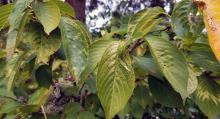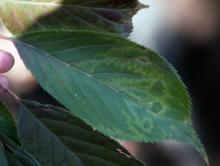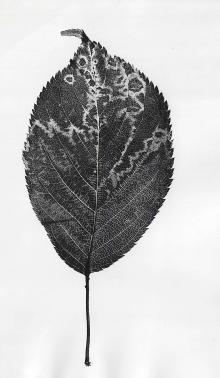See:
Cherry (Prunus spp.) - Little Cherry
Cherry (Prunus spp.) - Rasp Leaf
Cause Numerous viruses and virus-like pathogens can cause problems in Prunus. Many of these pathgens are eliminated by intensive cleanup programs; however, reinfection can occur at any time. Some Prunus cultivars are selected for unusual horticultural properties that are lost once they go through the virus cleanup procedure. Prunus serrulata can show symptoms of American plum line pattern virus, cherry green ring mottle virus and is an indicator host for cherry rasp leaf virus. Flowering types may also be symptomless carriers of several important tree fruit viruses such as cherry mottle leaf, little cherry diseases (virus 1 and 2) or others not found in North America. Little cherry virus can be carried by Prunus serrulata, 'Kwanzan' and 'Shirofugen' and has also been referred to as K&S disease.
Symptom development may be dependent on environmental conditions. Day length and temperature often influence symptom development. For example, trees can show symptoms in the spring and early summer but show no leaf symptoms later in the growing season, even though they are still infected. Shock symptoms may develop in some trees when they are initially infected, but the trees may show few or greatly subdued symptoms in future years. Trees can be infected by more than one virus, making visual diagnosis even more difficult.
Symptoms A wide variety of symptoms can occur, from deformed to off-color leaves, leaf chlorosis, veinbanding, leaf necrosis, shot hole, puckering, enations, ring spots, defoliation, stunted shoot growth (including shortened internodes), and reduced flowering. Symptoms can easily be confused with nutritional disorders, herbicide injury, and damage due to unfavorable environmental conditions. Enations, line patterns and veinbanding symptoms, however, are more consistently associated with only virus infection. Testing is usually required for accurate diagnosis.
American plum line pattern virus - symptoms include banded chlorosis, whitish or pinkish discolored areas, large rings but more often oak-leaf patterns.
Cherry green ring mottle virus - symptoms include twisting and curling of leaves, leaf vein necrosis, epinasty, shoot stunting, rough cracked bark, stem pitting and terminal dieback.
Rasp leaf virus - prominent projections (enations) on undersides of leaves that take the shape of leafy outgrowths or raised protuberances between lateral veins and along the midrib.
Cultural control
- Thermotherapy (24 to 32 days at 38°C) and/or apical meristem culture have been used to eliminate various viruses.
- Promptly remove infected trees when identified.
Reference Hadidi, A., Barba, M., Candresse, T., and Jelkmann, W. 2011. Virus and Virus-like Diseases of Pome and Stone Fruits. American Phytopathological Society, St. Paul, MN.




